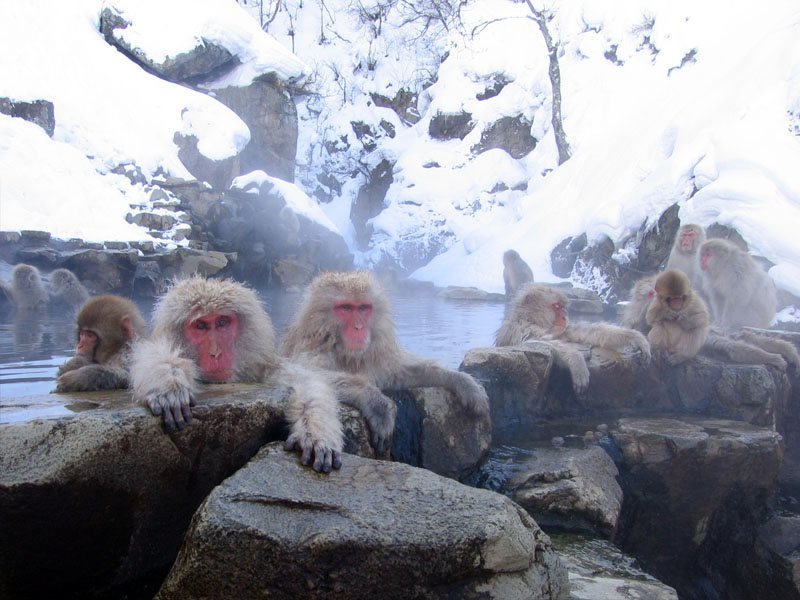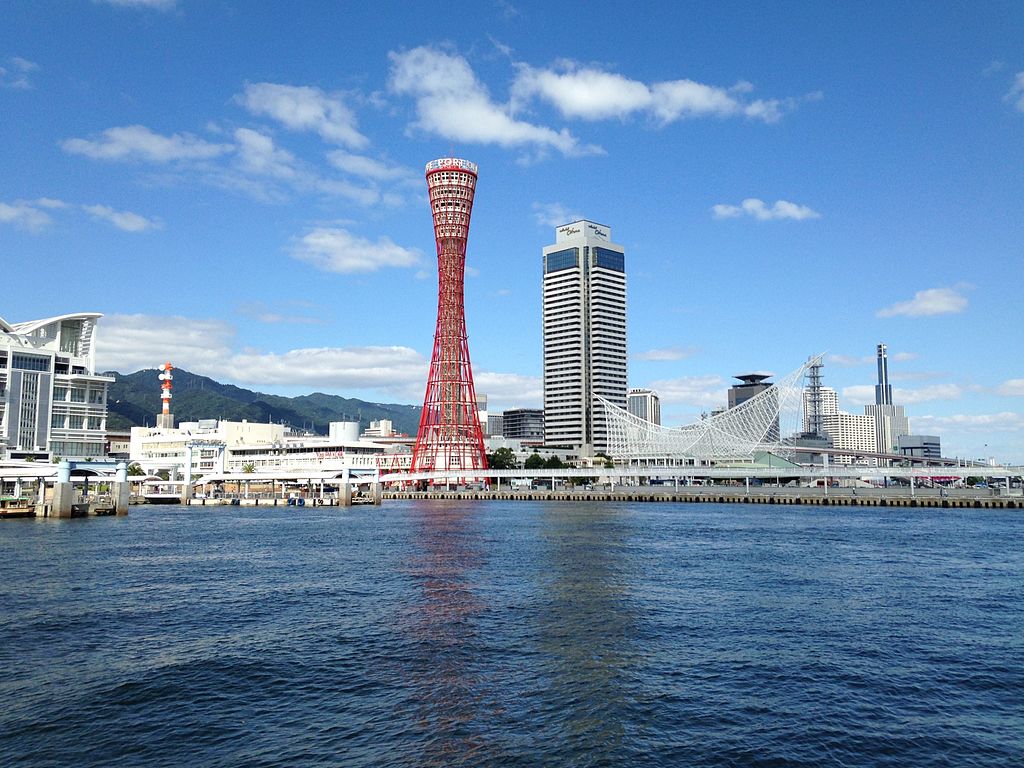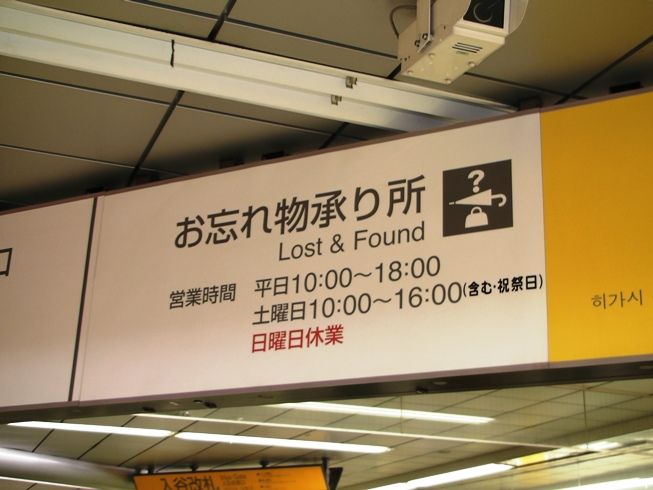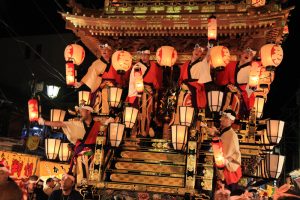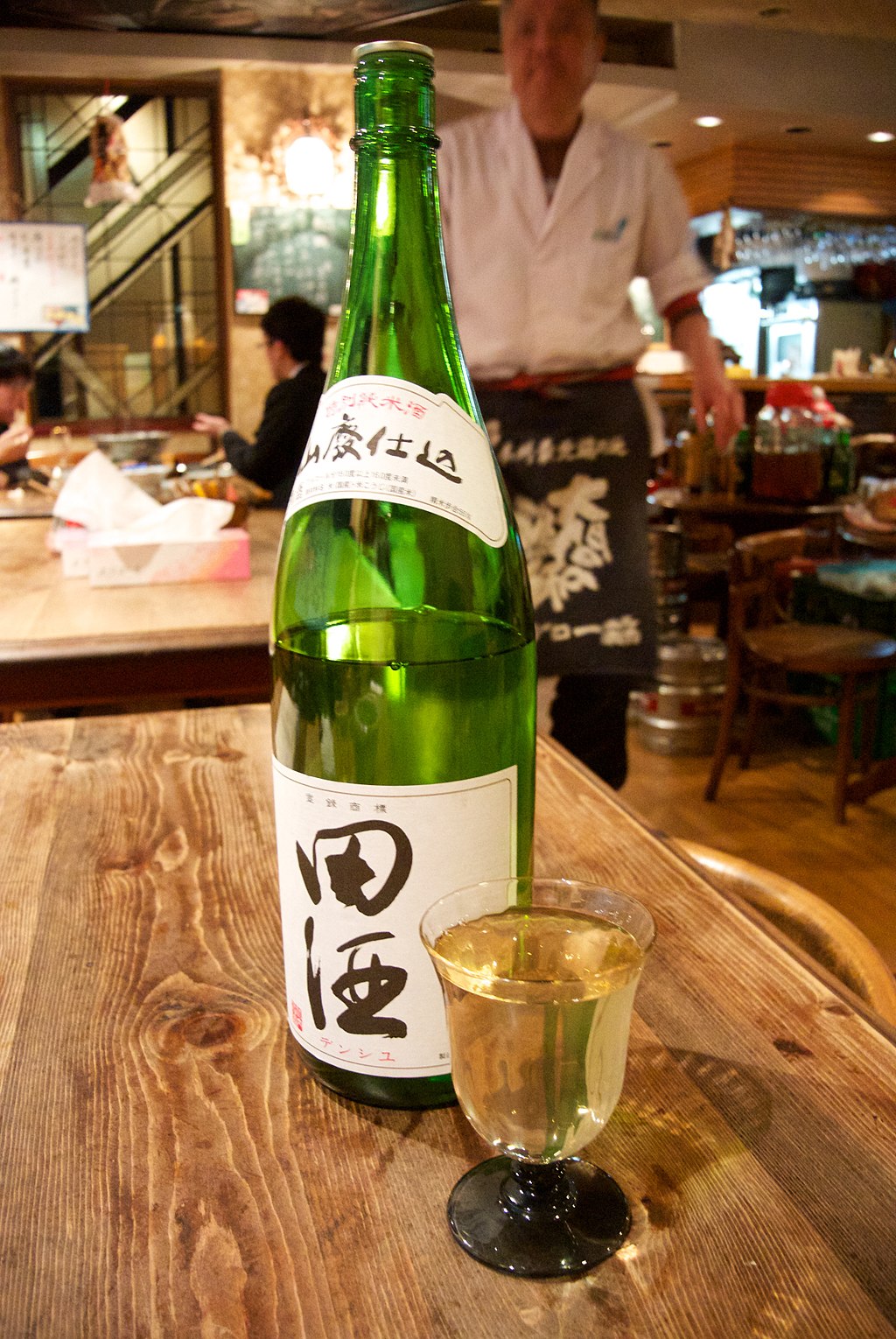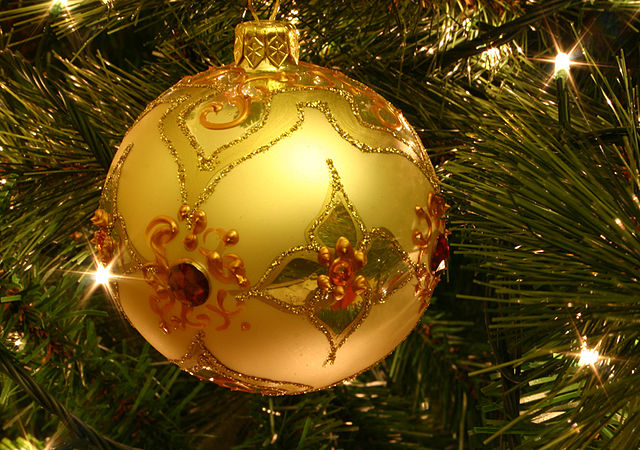Dec 17, 2019
The Best Izakaya in Kobe
In Japan, a popular activity after a long day of work is a visit to an izakaya. A type of informal bar, izakaya serves alcoholic drinks and (often quite substantial) food. Patrons continue to order throughout the evening, receiving a bill at the end. Most cities have numerous izakaya and Kobe is no exception.
Hanbey
A retro-style izakaya with walls plastered in Japanese posters to take you back in time, Hanbey is a low-lit establishment in downtown Kobe. The setting is ideal for sharing snacks and trying some original drinks, all at affordable prices.
Location: 2-minute walk from Kobe-Sannomiya station
1-7-6 Kitanagasadori, Chuo Ward, Kobe 650-0012 (map link)
Hours: 5:00 p.m. to 12:00 a.m. (until 1:00 a.m. on Fridays and Saturdays)
Tamian
For more of a meal head to Tamian, an izakaya specializing in seasonal dishes of seafood and meat for patrons who want to eat late into the night. If you’ve ever seen the Japanese TV show Midnight Diner, you’ll feel like you’ve walked right onto the set.
Location: 3-minute walk from Kobe-Sannomiya station
2-1-5 Shimoyamatedori, Chuo Ward, Kobe 650-0011 (map link)
Hours: 11:30 a.m. to 2:00 p.m. and 6:00 p.m. to 5:00 a.m., closed on Sundays
Gonta
Alternatively, if you’re looking for a place that opens early in the afternoon, check out Gonta. There’s even a happy hour on beer before 6 p.m. One of the best-known izakaya in Kobe, it’s popular with everyone from executives to college students. The prices are reasonable and quality is high, but be aware that it can get quite loud.
Location: 4-minute walk from Kobe-Sannomiya station
2F, 1-31-26 Kitanagasadori, Chuo Ward, Kobe 650-0012 (map link)
Hours: 4:00 p.m. to 11:00 p.m. (from 12 p.m. on weekends)
Nouka
Vegetarians may find they have limited options when dining at an izakaya. Nouka, however, is fully vegetarian and has options for vegans. Plus, all the vegetables are locally sourced and organic. It’s also a great choice for those looking for something healthy.
Location: 3-minute walk from Motomachi station
4-2-17 Kitanagasadori, Chuo Ward, Kobe 650-0012 (map link)
Hours: 5:00 p.m. to 11:00 p.m. (until 12:00 a.m. on Fridays, Saturdays, and Sundays)
Kokoroya
At Kokoroya you can combine the izakaya experience with Kobe beef. The establishment has both a set menu and another menu just for beef. The meals are much heavier than at most izakaya.
Location: 3-minute walk from Motomachi station
1-1-1 Motomachidori, Chuo Ward, Kobe 650-0022 (map link)
Hours: 2:00 p.m. to 12:00 a.m. (closed Sundays)
Hatagoya
You won’t find fresher seafood than at Hatagoya. After you place your order, the chefs take the fish straight out from their tank.
Location: 5-minute walk from Sannomiya station
4-2-3 Kumoidori, Chuo Ward, Kobe 651-0096 (map link)
Hours: 11:30 a.m. to 2:30 p.m. and 5:00 p.m. to 11:00 p.m. (weekends until 10:30 p.m.)
Whenever you feel like relaxing in the evening during your time in Kobe, pay a visit to a different izakaya. Each offers a unique atmosphere, down to the seating arrangements.
Mx. Granger [CC0], via Wikimedia Commons
Dec 12, 2019
The Top Onsen Resorts in and Around Kobe
If you’re stressed out, had a tough week at work, or feel de-motivated, visiting an onsen is the perfect remedy for you. These hot spring baths will help you regain your energy and forget all your stress. In Japan, people have been visiting onsen for hundreds of years to cleanse their bodies and souls.
What is an Onsen?
You may have seen onsen in Japanese anime, drama, and movies — they are usually depicted as steamy public or private baths near mountain springs. Onsens are everywhere in Japan. Some are located within bustling cities, whereas others are relaxation havens in the mountains or on islands. Many onsens are traditional ryokans, which use natural aesthetics. Others are more modern, housed in classy hotels. Popular with locals and foreign visitors alike, onsen may even be one of the reasons why you want to visit Japan.
Tips for Visiting Onsen
Before discovering the best resorts in Kobe, it’s essential to learn how to experience onsen the Japanese way:
1. Bring shampoo, body soap, a small towel to use as a washcloth, a larger towel for drying, and a hairband or hair clips (if your hair is long enough for a ponytail). Slippers and hairdryers are usually provided.
2. The male and female bathing areas are typically separate. Men should head to the blue curtain marked with 男 and women to the red curtain marked with 女.
3. Be prepared to undress in front of other people of the same sex in the common changing room. You should undress completely, put your clothes in a basket, and then place the basket on a shelf. Only take your small towel, soap, and hairband to the bathing area.
4. Head to the small wash places along the walls and wash thoroughly (including your hair) before entering the tub. Be careful to avoid splashing soap and water.
5. Once finished washing, tie up your hair, clean the area, and put everything back for the next person to use.
6. After bathing, it is common to drink cold milk — many Japanese people say this is THE best!
7. Be aware that many public baths prohibit tattoos, particularly tattoos that cover a large part of the body. There is usually a “no tattoo” sign near the entrance at these places.
Top Onsen in Kobe
Kobe has some of the most luxurious, famous, and popular onsen in the country. This should come as no surprise since Kobe is one of the most attractive places in Japan, a renowned historic port city, and located close to the mountains.
Ninomiya Onsen
This charming onsen is close to Sannomiya station in downtown Kobe. It is actually a sento bath, meaning the pools use heated tap water. However, there is one pool filled with real onsen water. Rich in minerals, it has a distinct metallic scent. There is nothing extraordinary about Ninomiya Onsen, but its low price makes it an ideal place to go several times a month — or even multiple times a week. Plus, it also has a salt sauna.
Address: 4-2-18 Ninomiyacho, Chuo Ward, Kobe
Open Hours: 2:00 p.m. to 10:00 a.m.
Price: 450 yen
Minatoyama Onsen
Although it’s some distance from the city center, Minatoyama Onsen is still easy to reach by public transportation — and it’s certainly worth a visit. The resort has five different onsen pools at different temperatures ranging from 26 degrees Celsius to 46 degrees Celsius. The price is midrange, definitely not too high for what you receive. Plus, it’s one of the few baths that allow people with tattoos to enter.
Address: 26-26-1 Minatoyamacho, Hyogo Ward, Kobe
Open Hours: 5:00 a.m. to 10:30 p.m. (last entry 10:00 p.m., closed Wednesdays and public holidays)
Price: Adults 680 yen (500 yen between 5:00 a.m. and 7:00 a.m.), junior high students 430 yen, elementary school students 230 yen (100 yen on weekends), infants enter free
Arima Onsen
In this small but famous onsen village behind Mount Rokko, there are two natural hot springs called Kin no Yu (meaning Golden Spring) and Gin no Yu (meaning Silver Spring). Their names come from the colored water, which is rich in minerals and has many health benefits, especially for the skin. It’s worth spending a whole day in Arima Onsen, as the town is beautiful. You can even stay overnight in a ryokan with your own private bath.
Address: 833 Arimacho, Kita Ward, Kobe
Open Hours (Kin no Yu): 8:00 a.m. to 10:00 p.m. (last entry 9:30 p.m., closed second and fourth Tuesday of each month, Wednesday if Tuesday is a holiday, and January 1)
Open Hours (Gin no Yu): 9:00 a.m. to 9:00 p.m. (last entry 8:30 p.m., closed first and third Tuesday of each month, Wednesday if Tuesday is a holiday, and January 1)
Price (Kin no Yu): 650 yen
Price (Gin no Yu): 550 yen
Price (both): 850 yen
Gekkoen Korokan
Nestled behind Mount Rokko is one of the oldest onsens in Japan. Although Gekkoen Korokan is outside the metropolitan area, it is easily accessible. In addition to the hot baths, amenities include free-flowing beer and cooking classes.
Address: 318 Arimacho, Kita Ward, Kobe
Open Hours: 11:00 a.m. to 3:00 p.m.
Price (lunch included): Adults 3,800 yen, elementary school students 2,300 yen, preschoolers 1,750 yen, infants free
Kobe Minato Onsen Ren
What could be more lovely than lounging in a steamy bath while looking out at the ocean? This modern hotel resort, located by the harbor, combines traditional and contemporary amenities to bring you pure luxury. Your room will have its own terrace with views of the bay. To reach Kobe Minato Onsen Ren, take a five-minute shuttle bus from Sannomiya station.
Address: 1-1 Shinkocho, Chuo Ward, Kobe
Price (for a room): From 16,000 yen
Awaji Hamarikyu
Enjoy a private bath in your room overlooking the beach. Situated on Awaji Island, this onsen resort is surrounded by splendid views of the countryside. The ryokan has Japanese style, Japanese/Western-style, and Western-style suites to suit your preferences.
Address: 970-81 Matsuhokotsuro, Minamiawaji
Price (for a room): From 15,000 yen
Tocen Goshoboh
If you’re a history buff and would love the chance to pamper yourself in an 800-year-old ryokan, this onsen resort (located just 40 minutes from Kobe Airport) is for you. Feast on delectable Yamaga cuisine from the Kamakura period. Then, plunge into your own private hot spring and allow the warmth to seep into your body and soul. Tocen Goshoboh even provides guests with their own yukata to complete the traditional feel.
Address: 858 Arimacho, Kita Ward, Kobe
Price (stay and spa): 10,200 yen
Hyoe Koyokaku
Just 100 years younger than Tocen Goshoboh, Hyoe Koyokaku has a “golden spring” — its yellow color is due to the iron and salt in the water. You can choose between three public baths or take advantage of the peace and quiet offered by a private bath. This gem of a resort also serves a multi-course Kaiseki menu that is sure to please any tastes. To arrive, it’s just a six-minute walk from Arima Onsen station.
Address: 1904 Arimacho, Kita Ward, Kobe
Open Hours: 6:00 a.m. to 1:00 a.m. (5:00 a.m. to 11:00 p.m. for San-no Yu bath)
Price (for a room): From 29,500 yen
Kaigetsukan
Right by the beach on Awaji Island, and with amenities including a hot spring bath, a spa, table tennis, and billiards, you’ll want to spend more than a day at Ryokan Kaigetsukan. It’s a great place to stay during your time in Kobe, as everything else in the city is easily accessible. This is an onsen you’ll want to make your home away from home.
Address: 1-3-11 Kaigandori, Sumoto
Price (for a room): From 6,500 yen
Taketoritei Maruyama
Foodies who travel for gastronomical experiences will love the sumptuous seafood and wild vegetables served at this onsen. Better yet, you’ll receive a sumptuous spread of food straight to your room. Feast until your heart’s content after a dip in one of the two medicinal hot spring baths.
Address: 1364-1 Arimacho, Kita Ward, Kobe
Price (for a room): From 40,000 yen
Awaji Island Uzushio Onsen Umemaru
Nothing beats staying at a hotel where you have a hot spring, a sauna, delicious seafood, and easy access to all the must-see destinations in the city. Awaji Island Uzushio Onsen Umemaru provides you with all those amenities and more. For instance, you can have a massage, try out Japanese pottery, purchase gifts from the on-site shop or send a postcard to loved ones using the onsen’s postal service.
Address: 1137-9 Arimacho, Anaga, Minamiawaji
Price (for a room): From 34,000 yen
Different onsen resorts cater to different types of guests. For instance, business people can choose onsen with golf courses and high-end facilities, whereas elderly visitors can find ones with special amenities to make their stay more comfortable. Families often enjoy having larger private bathing areas to bathe together. You can also choose between modern baths and traditional medicinal onsen (for their healing qualities). The onsen resorts in Kobe, from the traditional ryokans to the glamorous hotels, provide the exact type of relaxation guests from all walks of life want and need.
By Yosemite (Own work) [GFDL or CC-BY-SA-3.0], via Wikimedia Commons
Dec 12, 2019
Winter Days Out in Kobe
With many people on holiday from work, school or college over the Christmas winter period, it’s an excellent opportunity to look at things to do in the Kobe area if you fancy getting out of the house. There are many attractions in the city that are suitable for children, couples or even individuals if you have a spare few hours on your own. Here are a few suggestions for winter fun.
Relax at an onsen
What more delightful a way to warm yourself up on a cold winter’s day than visiting a Japanese hot spring (onsen)? The Arima Onsen, located not too far from Mount Rokko, is one of the most renowned in Japan and attracts visitors throughout the year. You can soak up the treatment from different types of spring waters, including Kin-no-yu (gold bath) and Gin-no-yu (silver bath), with both said to offer a cure for muscle and joint problems.
You can make a day of a visit to Arima as there are also plenty of dining options as well as evening entertainment, including Geiko performances.
Website: https://visit.arima-onsen.com/
Sample some traditional Japanese sake
Kansai is home to one of Japan’s primary sake-producing regions in Nada. Here, the favorable conditions and good quality rice mean that it has become a hub for different varieties of the national drink. There are many breweries in Nada open to the public, where you can learn about brewing techniques, buy souvenirs, and also sample some of the brews. Definitely a great way to warm the cockles on a cold winter’s day!
Websites:
http://www.hakutsuru.co.jp/english/
https://enjoyfukuju.com/en/
https://www.kikumasamune.com/
http://www.sakuramasamune.co.jp/
Enjoy winter sports at Rokko Snow Park
Mount Rokko National Park is one of Kobe’s top winter attractions. Open year-round and offering a range of activities and splendid panoramic views, it is popular in winter due to the family-friendly snow park, the only skiing facility in Kobe. In addition to skiing and snowboarding opportunities for all abilities, there are many other attractions to enjoy, including an observatory, a restaurant, and a children’s play park.
Website: https://www.rokkosan.com/ski/en/
Have a family day out at Kobe Harborland
Fancy a bit of wintertime shopping and maybe picking up a few bargains in the seasonal sales? Head down to Kobe Harborland. This shopping and entertainment complex located close to Kobe Port contains over 200 shops of all varieties. In addition, there are children’s’ amusements, including a big Ferris wheel, a museum dedicated to the Anpanman character, and a selection of restaurants and cafes.
Website: https://www.harborland.co.jp/
Sample some culture at the Hyogo Prefectural Museum of Arts
If you fancy a spot of culture, this municipal art gallery that opened in 2002 could do the trick. It’s a three-story building that includes sculptures, prints, and paintings, among other kinds of art. The modern minimalist style of the building’s architecture was the brainchild of the Japanese architect Tadao Ando.
Website: http://www.artm.pref.hyogo.jp/eng/
そらみみ (Soramimi) [CC BY-SA 4.0], from Wikimedia Commons
Nov 26, 2019
How to Get Lost Stuff Back in Japan
One day you’re out running errands just after work. You step off the train at your home station and walk over to the bank to use the ATM to check your finances and get some cash out for that one shop that still hasn’t gone cashless. After you pop into the convenience store to pick up something to munch on and notice your wallet is missing. “Don’t panic,” you tell yourself as you rush back to the bank. The small ATM corner is empty and there are zero wallets around. The pit our stomach begins to churn at the thought of having to stop everything, rush home and cancel any bank cards, deal with reissues of identification cards, and perhaps the loss of whatever cash was in your now missing billfold. But if this scenario plays out here in Japan, you can relax a bit; there is about an 88% chance you’ll get your belongings back to you all in one piece!
The story above happened to me in the late winter of 2015. After living here for well over 10 years at that point, I had already left various things onboard trains and buses, forgotten my cellphone in too many restaurants to count, misplaced a whole 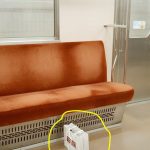 bicycle (!), and lost keys and wallets a few times to boot. All of them were found and retrieved between a few minutes and a few days, thanks entirely to the generosity of Japanese people in general, and a very efficient and well structured lost and found system that has been in place for literally centuries. When you first notice your item is missing is key to where to start your quest to get it back.
bicycle (!), and lost keys and wallets a few times to boot. All of them were found and retrieved between a few minutes and a few days, thanks entirely to the generosity of Japanese people in general, and a very efficient and well structured lost and found system that has been in place for literally centuries. When you first notice your item is missing is key to where to start your quest to get it back.
In my case, I knew that I must’ve left my wallet in the ATM stall because it was the last place I used it, and was fresh in my mind. I also had a high chance of returning to the scene and seeing it sitting right there next to the cash machine; oftentimes nobody will touch something obviously misplaced for a few hours because they expect that person to come back looking for things. Look hard enough around town and you’ll see a glove sitting atop a park bench or a child’s umbrella leaning against a street lamp for example. Going back to the source within the first few minutes or hours is the easiest and usually most successful outcome. In almost every case, I’ve gotten my stuff back including a very expensive camera. But in the above situation, my wallet was nowhere to be found. That sick feeling in my gut intensified greatly.
Don’t panic!
Had the bank been open, I’m sure someone would have alerted the staff and I could claim it from them, but this was on a Sunday so the only answer could be someone must have gotten it. I needed to make a police report just in case. Directly across the street was a koban, small booths scattered all over Japan by police and used by them and the community to be a point of presence. Usually, there’s an officer manning the booth but even if they’re on patrol, there’s a phone with a direct line to the nearest police station that can be used by anyone. I used this to give an account of my lost wallet and made a claim over the phone. I was told I could pick up the form in 2 days but I should also contact the bank since it was lost in their building. I did this as well, also putting a suspension on my bank cards. (In my case, I have another bank account whose ATM card I never carry, and simply switched over to that one temporarily. Always have a backup plan for when you are in a similar predicament!) I was prepared to reissue my driver’s license and Japan alien card but there was no need; when I went to pick up a copy of the lost item claim from the police station a few days later, they already had my wallet there waiting for me. Some kind soul found it 5 minutes after I left the ATM and handed it over to a police officer in the short time I was at the convenience store!
Lost in Transit
Where you have misplaced your belongings is also key. Here in Tokyo where most people commute by train and bus, you should find a staff member of the line you’ve lost 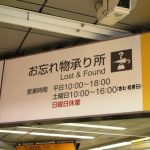 your item on as soon as possible. Once I got off the Chuo Line at Mitaka station and forgot a shopping bag in the overhead rack. I remembered the car where I was sitting and talked to the station staff on the platform and he was able to have someone get it at the very next station and hold it for me. If you aren’t so lucky, every line has a lost and found room, and there’s a good chance it’ll turn up there, ready for you to claim the next day. Bus lines are similar, with lost item rooms usually found at their depots.
your item on as soon as possible. Once I got off the Chuo Line at Mitaka station and forgot a shopping bag in the overhead rack. I remembered the car where I was sitting and talked to the station staff on the platform and he was able to have someone get it at the very next station and hold it for me. If you aren’t so lucky, every line has a lost and found room, and there’s a good chance it’ll turn up there, ready for you to claim the next day. Bus lines are similar, with lost item rooms usually found at their depots.
Where do all the lost things go?
If you haven’t been so lucky at regaining your lost thing after going through this, then you still have a bit of hope in the way of the Prefectural Lost Item Centers. For Tokyo, this will be at the Wasuremono Center in Ichigaya. Many organizations turn over all their lost items they’ve collected over to these centers after a few months. Essentially a large warehouse, every item is cataloged so it can be found online. Filling out that lost property report with the police is key as you won’t be reunited with your stuff without it.
Not finders-keepers…
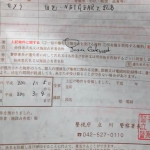 If you happen upon some other unfortunate soul’s lost property, you should pay it forward (or backward) and hand it over to the nearest building/transport/public authority. In some instances, you’ll be asked to fill out a little bit of paperwork detailing where the item was found and the condition along with your contact information. Once I found what I thought was a cheap watch but turns out it had major sentimental value; it was the last gift received from a young woman’s grandmother before she passed on and the young lady was very grateful to get it back, giving me ¥3000 as a finder’s fee along with a letter explaining things. So sometimes kindness does pay off! The flip-side to this is that if the item isn’t claimed in a certain amount of time, then you have the option to take it yourself.
If you happen upon some other unfortunate soul’s lost property, you should pay it forward (or backward) and hand it over to the nearest building/transport/public authority. In some instances, you’ll be asked to fill out a little bit of paperwork detailing where the item was found and the condition along with your contact information. Once I found what I thought was a cheap watch but turns out it had major sentimental value; it was the last gift received from a young woman’s grandmother before she passed on and the young lady was very grateful to get it back, giving me ¥3000 as a finder’s fee along with a letter explaining things. So sometimes kindness does pay off! The flip-side to this is that if the item isn’t claimed in a certain amount of time, then you have the option to take it yourself.
Images via Jason L. Gatewood
Nov 26, 2019
Chichibu Night Festival Near Tokyo
Located about 2 hours northwest of Central Tokyo, Chichibu is a small mountain community that is popular for weekend getaways thanks to it being the home of Chichibu-Tama-Kai National Park and a very picturesque and historic area. Celebrating some of that history is the Chichibu Yomatsuri night festival. This is Chichibu Shrine’s largest annual event and started some 300 years ago as a way to promote the textile and cloth market called Kinunotakamachi as well as give the townsfolk something fun to do as the days get shorter and nights get colder, all the while appeasing the local gods of course! This festival is one of the three biggest in Japan; the other two being the Gion Festival in Kyoto and Takayama Festival in Hida, Gifu. It’s a must-see as it was UNESCO registered back in 2016.
The dashi (山車) floats are the main attraction with their hand-carved decorations and meticulous designs. They can be seen blocks away due to their swaying lanterns hung about them; it used to be lit by candlelight when the festival began, but in the 21st century, LED lamps are the norm these days. Even so, the Hiki-Odori and Yatai Kabuki can be seen being performed on these portable stages throughout the evening along with Hayashi musical accompaniment. Also, you must admire the captains of these land-ships as they navigate the hills and hairpin turns of central Chichibu
The rare sight of a late fall/early winter matsuri is intensified with the thump and boom of fireworks going off over the skies of Dangozaka as seasoned festival-goers clamor over the money shot of fireworks blooming over the procession of dashi below.
When & Where
Date and Time: Held December 2nd (Mon) to 3rd (Tues), 2019; 2nd: Eve-Festival; 3rd: Main Festival
Place: In and around Chichibu Shrine and Chichibu Park
Access: Chichibu Station and Seibu Chichibu Station (SI36)
Web: https://www.chichibu-omotenashi.com/en/festivals.html#yomatsuri
Images: via Chichibu Tourism Organization
Nov 25, 2019
Toyohashi Zoo & Botanical Park – Non Hoi Park
Toyohashi Zoo & Botanical Park is a fun-packed day out for all the family, with animals, rides, beautiful spots, and flowers from all over the world. Also known as ‘Non Hoi Park’ (it means something like ‘hey, hey!’ in the local Higashi-Mikawa dialect) it is a zoo, botanical garden, amusement park, and a natural history museum contained within an abundant 40 hectare grounds and a place where people of all ages can learn and play.
Animal Magic
The concept of the zoo at Non Hoi Park is to engender a feeling of closeness with the animals in as near to their natural habitat as possible. There are some fourteen zones in which you can see around 900 hundred animals of 170 species.
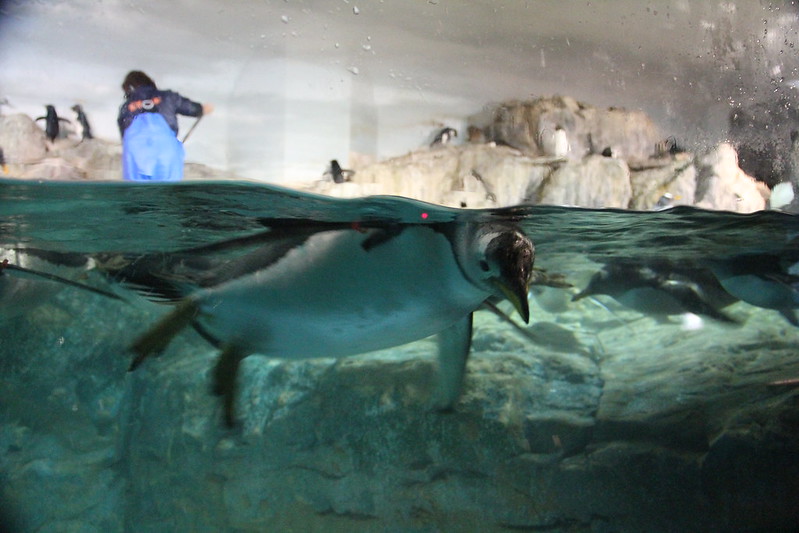
In the savannah zone, see zebras and giraffes roam wild, in the friendly farm meet and interact with sheep, miniature pigs, and rabbits amongst others, and in the polar zone, enjoy the penguins and spotted seals splashing about. Their tanks are displayed so that you can see the immense polar bears up close and personal as they dive into the icy water.
If you think that the park has too much to see in one day, or you are short of time, you can speed up the process by taking a segway tour, with full training provided on the day.
Beautiful Blooms
The botanical gardens are filled with a wide variety of plants and flowers that are changed according to the season, making it a peaceful and relaxing area to stroll any time of year, and an opportunity to stop life and smell the flowers.

Are you a budding artist? Do you want to witness a bit of history? Then you won’t want to miss Monet Corner, where you can see lilies, weeping willows, and wisterias that will make you feel that you are in a living painting by Claude Monet. And there is a good reason for that, as the water lilies themselves were donated to Hoi Noi Park by the gardens of the impressionist master himself to commemorate the park’s opening in 1996, making it the first place in Japan to have the flowers. Don’t forget to bring your easel (or your camera phone)!
From Nature to Natural History
Budding natural historians – or even those with a curious mind – will love exploring the Toyohashi Museum of Natural History, where you can discover the wonders of Earth’s evolution from the dawn of time right up to the present day.
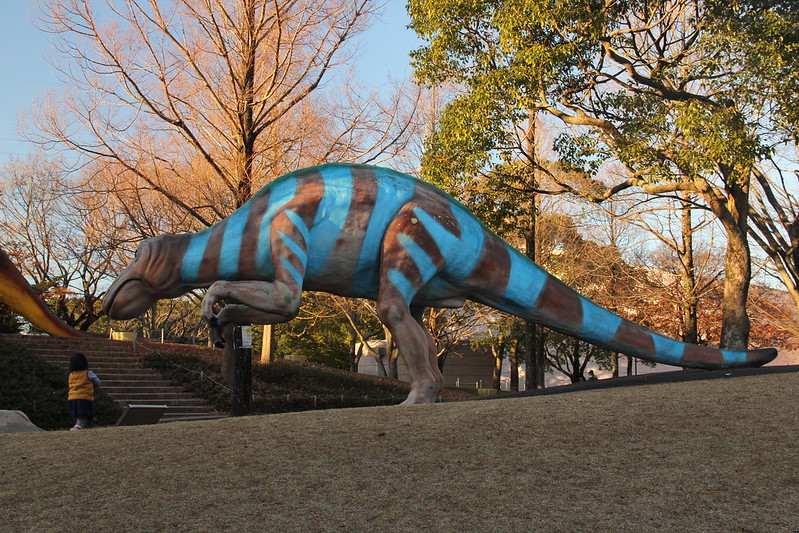
The centerpiece of the exhibition is the twelve dinosaur skeletons, including an imposing triceratops, a duck-billed Edmontosaurus, and the terrifying Tyrannosaurus Rex. There are also life-sized recreations of other great lizards, giving you a real understanding of what life might have been like amongst the beasts. You are free to wander the grounds alone, or you can take part in the guided tour, and special lessons should you so wish.
Amusing Yourself
Learning and education are all well and good, but sometimes we want to cut loose and have some fun, and that’s just what the amusement park is all about. There are twelve rides for you and your children to enjoy, including a merry-go-round, a children’s train, speedway go-karts, and a kids’ rollercoaster. There is also a Ferris Wheel, where you can take in view the entirety of Toyohashi City.
Rides cost between 100 and 300 JPY, but unlimited day passes are available, with adult tickets costing 1,000 JPY, meaning that you can play and play to your heart’s content.
Non Hoi Park Details
Where: 1-238 Aza Oana, Oiwa-cho, Toyohashi City (map)
Website: nonhoi.jp
Image: by Ana Paula Hirama via flickr.com [CC BY-NA 2.0] – Modified
Image: by Ana Paula Hirama via flickr.com [CC BY-NA 2.0] – Modified
Image: by Ana Paula Hirama via flickr.com [CC BY-NA 2.0] – Modified
Image: by Bong Grit via flickr.com [CC BY-NA 2.0] – Modified
Nov 25, 2019
Traditional Kansai Winter Drinks
The winter months in the Kansai region can get pretty cold, so what better way to warm yourself up than with a nice warm drink. These tasty beverages can be enjoyed throughout the year but make an especially welcome treat during the winter period.
Japanese tea
Tea is the most commonly drunk beverage in Japan. Green tea in particular is popular across the country and can be found served in cafes and restaurants everywhere. The most well-known Japanese green tea is probably matcha green tea, the slightly frothy brew made from powdered leaves. In the Kansai region, however, the most popular variety is probably uji green tea. This tea originated in Kyoto and has been consumed since its importation from China back in the 8th century. Don’t be surprised to be offered a nice cup of this after feasting on a festive meal this winter.
Other popular winter teas in Kansai include ginger tea (shogayu), made with fresh ginger that is great for heating the body and strengthening the immune system, and hojicha tea, where the leaves are roasted to produce a sweet caramel-like flavor. Hojicha tea is a good nighttime tea option as it has less caffeine than other teas.
Sake
The Japanese staple winter drink, hot sake will warm your cockles on the coldest of Kansai evenings. This rice wine is called nihonshu in Japan and is made from fermented rice. There are many different flavors and grades of sake depending on to what extent the rice has been “polished” to remove the bran. The highest grade is dai-ginjoshu, where only 50% of the grain remains. To be served properly at wintertime, sake is heated gently at about 45 degrees to enhance the flavor. Popular throughout the year across Japan, sake is especially valued in the Kansai region. The sake breweries in Nada produce approximately 25% of the country’s annual supply.
Amazake
Similar to sake in that it is another fermented rice drink, amazake differs as it has a much lower alcohol content. In fact, it can also be made alcohol-free. It’s a sweet-tasting beverage that can also be consumed cold – although it is much better hot on a frosty night! Amazake is served in tea houses, temples and even confectionery stores (the non-alcoholic version is sometimes sold as a sweet) across Kansai and is commonly drunk as a celebratory New Year beverage.
Coffee
Coffee isn’t quite as well established as a quintessentially Japanese drink as tea or sake, but make no mistake the Japanese are keen coffee drinkers and Kansai residents are no different. Starbucks in particular has capitalized on Japanese coffee culture and has opened up numerous outlets in places like Osaka, Kyoto and Kobe. During the Christmas season, the cafes serve up seasonal specialties such as gingerbread or eggnog lattes to help customers sip their way into the festive spirit.
Chanmery
Known as the Japanese party drink for children, Chanmery is a combination of the words “champagne” and “merry Christmas”. But fear not, there is no alcohol involved. Chanmery is a soft pop drink with a taste similar to carbonated grape juice. If you have children and attend a kids’ party in Kansai, expect to see glasses of chanmery passed around. It’s become synonymous with fun Christmas and birthday celebrations in the Kansai region and beyond.
Koichi Oda [CC BY-SA 2.0], via Wikimedia Commons
Nov 24, 2019
What is the ShichiGoSan Ceremony?
Traditionally held on November 15, the Shichigosan (七五三, literally 7-5-3) ceremony is a rite that originated around 750 AD in the Heian period to celebrate the passage into middle childhood for children in Japan. Back in those times, it was considered a blessing from the gods if a child made it past their 6th birthday due to the poor health conditions prevalent at the time. To distance themselves from the grief of losing babies, people believed their kids were the offspring of the gods until they turned 7; only then were they considered “earthly beings.”
This coincided with a number of old traditions: Children’s heads were shorn close-cropped until after the age of three (it didn’t matter the sex of the child), boys could wear hakama pants at the age of five, and girls aged seven could finally tie their kimono with more ornate obi, graduating from the simple cord used until then. Also, the odd numbers of 7, 5, and 3 are considered lucky numbers by lore, and so the ritual of visiting a local shrine to ward off evil spirits and invite luck into one’s life was also added.
Modern 7-5-3 ceremonies
These days, girls dress in kimono; boys as well; however, they are sometimes also dressed in western-style formal suits with short pants instead depending on the family. Girls age 3 and 7, along with 5-year-old boys, will be seen around shrines with their families during the weekends around this time, taking pictures and enjoying (or complaining about) their traditional garb.

Sometimes, due to an old method of calculating age in Japan where you are considered one year old at the time of birth, girls who have already turned or will turn two and six, or boys have already turned or will turn four during the calendar year will also attend. (As an aside, “one year old at birth” is the official system in Korea!)
Most people choose only to walk up to the shrine, toss in some coins, pray, and keep it moving. This is also an excellent opportunity to teach your little one how to do this as well. It’s more of a “coming out” party for the children and a photo op for parents and family.
Can foreigners and tourists do this?
Of course! There are kimono rental shops everywhere in Japan, and most shrines will have amenities like free parking and special areas for those participating in the ceremony. Just inquire at your local shrine to see when their Shichigosan ceremonies are. While mid-November is the traditional date, many shrines perform the ceremony at other times throughout the year.
Many photo studios located immediately adjacent to larger shrines have all-inclusive photoshoots arranged in cooperation with the shrine, so be sure to check around for those as well.
— Images by Jason L. Gatewood
Nov 24, 2019
Sell Your Used Stuff on Mercari
Japanese accommodations are notoriously small for my American hoarding habits, and I occasionally draw the ire of my wife and encouraged to “consider paring down” some of my possessions. This used to mean bugging friends and co-workers or heading to the local Second Street, Hard Off, or other “recycle shop” secondhand store, only to get back little more than train fare for my item.
Online options are a little better; I’ve used Craig’s List and Facebook “For Sale” groups for over a decade with decent results but there’s still the hassle of dealing with haggling with buyers wanting pictures from every imaginable angle, a detailed usage history, and hand delivery to the most remote part of Japan possible that leaves a bad taste in my mouth. The result is that I only use these options when I’m shifting flats, or my used item is an obvious high-value like a smartphone, PC, or appliance. Everything else these days gets the “sodai-gomi” treatment and carted off to the trash heap.
But that was before I discovered Mercari.
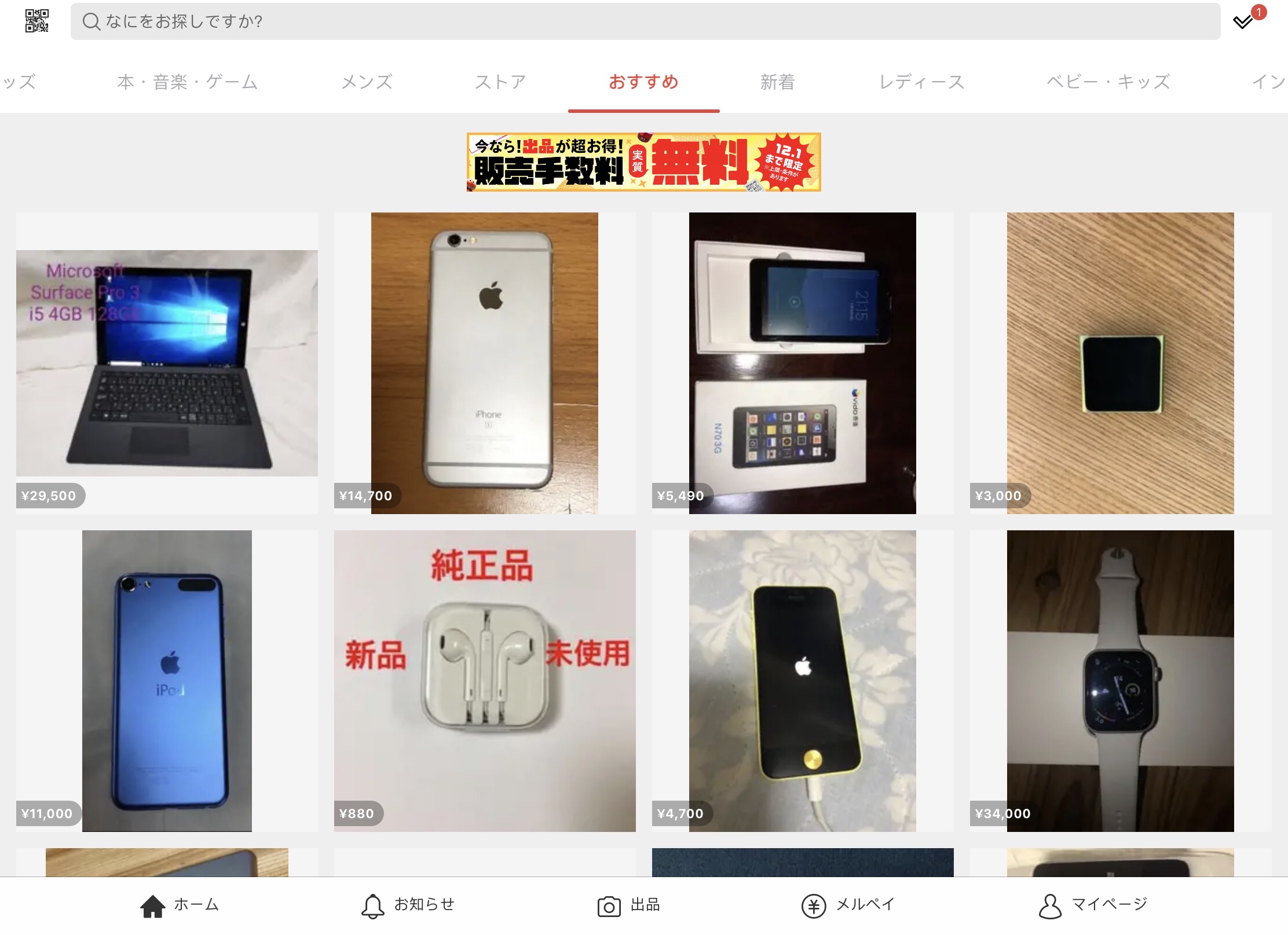 Mercari is an online marketplace that allows regular folks to sell to other regular folks in “flea market” or “swap meet” style, in the vein of a flashier eBay; if you’ve used that site before. Unlike that site above, though, you can create an account, take pictures, write a quick description and be up and selling in about 5 minutes flat with Mercari. Plus, the fee is a 10% commission on the item’s selling price. Are you selling something for ¥10,000? Then Mercari gets ¥1,000 with no hidden listing charges or extra fees whatsoever.
Mercari is an online marketplace that allows regular folks to sell to other regular folks in “flea market” or “swap meet” style, in the vein of a flashier eBay; if you’ve used that site before. Unlike that site above, though, you can create an account, take pictures, write a quick description and be up and selling in about 5 minutes flat with Mercari. Plus, the fee is a 10% commission on the item’s selling price. Are you selling something for ¥10,000? Then Mercari gets ¥1,000 with no hidden listing charges or extra fees whatsoever.
Really the only catch is that the app and the entire marketplace is in Japanese… Hey, don’t go heading for the hills just yet; you just need some basic Japanese terms along with the power of Google Translate to help you in a pinch.
Having a way with words
Let’s tackle the most intimidating part first: the product title and description. You just need to make sure to write well enough so that the algorithm program on the site classifies and places your ad into searches that match the item the customers are looking for.
-
- Title This should be concise and include the brand name, model, and top specs. Only the first 13 characters will count, so be brief! Here’s an example title straight from the site: ”【保証書付】iPad mini5 64GB wifiモデル スペースグレー” which translates as “(Insurance Card Included) iPad mini5 64GB Wi-Fi model Space Gray”. It also works for clothing: “ユニクロ メンズ ダッフルコート XS コート アウター 小さいサイズ” which is “Uniqlo Men’s duffle coat XS coat outerwear small-sized.” Pack as much info in there as possible, and don’t be afraid to check other similar items in the app first to see how other sellers have worded it.
- Description When selling something used in Japan, I find it easier to just go into detail on whatever imperfections due to regular use of the item, no matter how small it might be. Japanese customers don’t like to be caught off-guard even though it could be something as obvious as a small scratch on the housing of a 3-year-old PC or a small stain on the back of a sofa due to regular use. Not disclosing these seemingly trivial issues will net you a negative review and possibly a returned item. In my short experience, simply stating the obvious has never hurt me. Some ways to do this are shown in the following examples:
持ち運びに便利な○○です
This is an XX that is easy to carry
〇〇のために使用していました
I used this item for XX
一回しか使ったことないので、新品に近いです。
I only used it once, so it is almost as good as new
2-3回程度使いまして、目立った傷や汚れはありませんが、中古なので神経質な方はご遠慮願います。
I used the product 2-3 times. It doesn’t have any noticeable damages or stains, but it is still second-hand so people who are nervous about such are kindly asked to refrain from buying.
おそらく気にならない程度と思いますが、傷汚れありにしました。中古ですのでご理解ください。
It is probably not anything significant, but I’ve set the condition of the product to “has damages and stains”. Please be understanding as this is a second-hand product.
中古のため、多少傷が付いていますが、ご了承ください。
Please note that this product is old and has a few damages.
Using phrases like these will help clear the air and set the expectations for your particular item.
A picture is worth…well you know…
Of course, you know you’re going to need to take some decent pics of your item to post it for sale. The app makes good use of whatever smartphone or tablet you’re using, so kudos if you have a brand-spanking-new iPhone or Galaxy that can take pictures in the pitch darkness of space and make them all studio perfect. For the rest of us, though, you can also use your “good camera” to get the shots and save them to your phone’s memory and post them that way too. Make sure to take pictures of those imperfections we talked about above, and if possible, get angles of the item while in use to show it still works and in relation to other objects to show scale; people trying to buy your old sofa or bookshelf will appreciate that!
 The price is right!
The price is right!
Setting the sale price is a dicey affair for sure. You need to be fair for the item being used yet competitive with similarly categorized items. Also, Japanese buyers are finicky with cost—- pricing your item in the basement will make viewers think it’s too cheap, and something must be wrong with it, thereby passing it over. You need to do some research on the app and set your price in the same ballpark as others, even if you are trying to hurry up and get rid of it. Your transaction history is public record, and once you become known for frequently changing the prices after your initial posting, it’ll be hard to ditch that reputation. Stick to your guns! Remember, if your item hasn’t sold in about five days, just delete it, wait a day and repost it with a lower asking price.
SOLD!
Once you have a willing buyer, you’ll get a notification in the app, an email to your registered account, and so forth. The buyer will get automated notifications from the system saying you’re in the process of getting their order together to send out, but because Japan is Japan, you should also send a personalized message like “この度はご購入いただき、ありがとうございます。
お支払いのご確認が取り次第ご送付させていただきます。引き続き、どうぞよろしくお願いいたします。(Mr/Ms xx, thank you for your purchase. I will send the product as soon as the payment has been confirmed. Thank you!)”
Also, make sure you’ve posted your item with shipping included in the pricing (something you set in the listing process) or else be prepared for endless haggling! Sending the item is very easy these days since there are partnerships with FamilyMart and Lawson’s convenience stores for obtaining the packaging materials and then sending the item out from the convenience store itself instead of making an extra trip to the post office or delivery service. A barcode will be generated in the app that the conbini worker scans and just follow their instructions from there. Easy as pie.
 Profit!
Profit!
As long as you’ve set up your 振り込み申請 (Furi-Komi shinsei bank transfer application) properly, your proceeds will be transferred into your bank account on a certain day minus the standard bank transfer fee of ¥220. Another alternative is to use their MerPay service which gives you a virtual account to spend from on either the Mercari site itself or by using barcodes at participating shops and even a virtual MasterCard debit card in ApplePay and the iD eMoney network (my preferred route)
For more information…
Here are some other useful tidbits about Mercari in English on the web:
Nov 21, 2019
Buying a Christmas Tree in Nagoya 2019
If you are in the market for a Christmas Tree to liven up your holiday season you with trim and presents, you are in luck. Stocks are very limited so, don’t delay! The trees are a bit shorter than you might get used to but they have very nice shapes and I am certain they will bring you a Merry Christmas.
Real Christmas Trees
Ikea(from November 21)
The local Ikea is a reasonably good source for trees and decorations. Best of all, they offer live trees!
www.ikea.com/jp/en/search/?query=christmas
www.ikea.com/ms/en_JP (Store locator)
DCM Kahma 21, Toyota Shop
They have fir trees but their stock is very limited, which will not be restocked.
Small size: 1m cost: JPY 5475
Medium size: 1.5m cost: JPY8778
Large size: 2m cost: JPY 17380
Address:4-1-1 Uwagoromo, Toyota (豊田市上挙母四丁目1番地1)
Phone: 0565-36-2000
Map & Info
Other Home Centers
Around the holiday season you can find real or artificial trees, lights, displays and other assorted holiday decorations at many of these stores around Nagoya. What is in each one is impossible to say, but its worth a shot!
Artificial Trees
If the options above are sold out or are simply unwilling to deal with pine needles there is always the artificial option.
Foreign Buyers Club (Online)
We probably dont have to tell Kobe about FBC,but just in case… FBC isBilled as “Food and Fun from home – direct to your door – anywhere in Japan;” this online international grocery store has been delivering the goods to the broader expat community in Japan since 1988. They have “pine trees” in various sizes, but they sell out quickly.
Costco
You can get trees, decorations and paper here but you will find a small selection to choose from. On the plus side, they also stock lawn reindeer and tacky giant lawn Santa.
www.costco.co.jp/p/locations?lang=en
Shimo Jima
Shimo Jima products such as stationery and store decoration merchandise, as well as wrapping goods. They ususally have artificial trees for shops holiday displays and they are pretty cheap to top it all off.
www.shimojima.co.jp/eng/shop.html
Don Quijote
Don Quijote stores are huge, and seem to stock everything. Christmas decorations may be touch and go depending on which shop you try, but you can assume they will have SOMETHING for you.
Loft
Loft has a small selection of artificial trees, and several convenient locations around the area.
Tokyu Hands
Tokyu Hands has a small selection of artificial trees, and several convenient locations around the area.
Home Centers
Around the holiday season you can find real or artificial trees, lights, displays and other assorted holiday decorations at many of these stores around Nagoya. What is in each one is impossible to say, but its worth a shot!
(Online) Nitori
Nitori has a number of decorations and a small artificial few trees. If you are looking for Christmas lights, for some reason Nitori has a wide selection of them.
(Online)Amazon Japan
Amazon Japan is a good source for trees and decorations, probably one of the widest selections available in fact.
By Kris De Curtis (Flickr) [CC BY 2.0], via Wikimedia Commons

